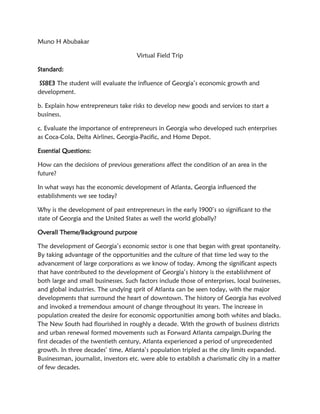
Virtual field trip
- 1. Muno H Abubakar Virtual Field Trip Standard: SS8E3 The student will evaluate the influence of Georgia’s economic growth and development. b. Explain how entrepreneurs take risks to develop new goods and services to start a business. c. Evaluate the importance of entrepreneurs in Georgia who developed such enterprises as Coca-Cola, Delta Airlines, Georgia-Pacific, and Home Depot. Essential Questions: How can the decisions of previous generations affect the condition of an area in the future? In what ways has the economic development of Atlanta, Georgia influenced the establishments we see today? Why is the development of past entrepreneurs in the early 1900’s so significant to the state of Georgia and the United States as well the world globally? Overall Theme/Background purpose The development of Georgia’s economic sector is one that began with great spontaneity. By taking advantage of the opportunities and the culture of that time led way to the advancement of large corporations as we know of today. Among the significant aspects that have contributed to the development of Georgia’s history is the establishment of both large and small businesses. Such factors include those of enterprises, local businesses, and global industries. The undying sprit of Atlanta can be seen today, with the major developments that surround the heart of downtown. The history of Georgia has evolved and invoked a tremendous amount of change throughout its years. The increase in population created the desire for economic opportunities among both whites and blacks. The New South had flourished in roughly a decade. With the growth of business districts and urban renewal formed movements such as Forward Atlanta campaign.During the first decades of the twentieth century, Atlanta experienced a period of unprecedented growth. In three decades’ time, Atlanta’s population tripled as the city limits expanded. Businessman, journalist, investors etc. were able to establish a charismatic city in a matter of few decades.
- 2. Lesson Activity: Students will choose anywhere from 6-8 pictures provided, analyze the significance of the presented landmark, or feature. After analyzing significance, students are to construct a then and now interpretation of how this feature has changed from its early development to its importance in the 21st century. After completing evaluation students are to illustrate their responses by composing a collage of selected landmarks.
- 3. It began in Atlanta as M. Rich Dry Goods general store in 1867. It was renamed M. Rich & Co. in 1871, when his brother Emanuel joined him; it was again renamed M. Rich & Bros. in 1876 when the third brother Daniel joined. In 1901 it became a true department store by dividing merchandise into separated sections, and was incorporated as M. Rich & Bros. Co. It became simply Rich's in 1924. Two innovative ideas that Rich tried were the barter system and a credit system.
- 4. Resurgens 1847-1865;" the word meaning "rising again," the first date marking the year the city's first charter was granted and the second date signifying the year of the beginning of the city's rehabilitation after its destruction by the Federal armies in 1864. The seal shall remain in the office of the Clerk of Council and shall not be affixed to any instrument except by order of the Mayor.
- 5. Symbolizing Atlanta's rise from the ashes of the Civil War to become one of the most important cities in the world. The sculpture, dedicated in 1969, depicts a woman being lifted from flames by a phoenix, in reference to the phoenix of Egyptian mythology that was consumed by fire and rose from the ashes, just as Atlanta rose from the ashes after being burned to the ground by William T. Sherman's Union Army during the Civil War.
- 6. Fairlie-Poplar developed during the late 19th century, when Atlanta emerged as the commercial center of Georgia and the Southeast. At the time, the area was promoted as "Atlanta's new modern fireproof business district". It constituted a major northward expansion of Atlanta's post-Civil War business district. Part of the central business district in downtown Atlanta. It is named for the two streets that cross at its center, northeast-only Fairlie and southeast-only Poplar.
- 7. Originally intended as a patent medicine when it was invented in the late 19th century by John Pemberton, Coca-Cola was bought out by businessman Asa Griggs Candler, whose marketing tactics led Coke to its dominance of the world soft-drink market throughout the 20th century.
- 10. The First National Bank of Atlanta (also called First Atlanta) is the successor bank to Atlanta National Bank, which was federally chartered in September 1865, after the Civil War (1861-65). It is the longest continually operating banking organization in the city of Atlanta. For a number of years in the mid-twentieth century, the First National Bank of Atlanta was the largest commercial bank in the southeastern United States, as measured by bank deposits
- 11. The buildings were constructed during Atlanta's post-Civil War Reconstruction Era boom, between 1866 and 1871, when the city's population doubled from 11,000 to 22,000 residents. In 1869, the Georgia Railroad freight depot was constructed to replace the one destroyed by Sherman's troops in 1864
- 12. The rise of Auburn Avenue as "the" black business district in Atlanta was to a great extent an outcome of the 1906 Atlanta Race Riot. Prior to this time black businesses operated largely in downtown Atlanta — a business district integrated as far as business ownership was concerned. But competition between working- class whites and black for jobs and housing gave rise to fears and tensions. In 1906, print media fueled these tensions with hearsay about alleged sexual assaults on white women by black men, triggering the riot.
